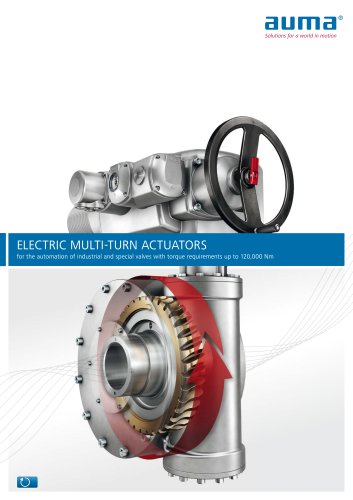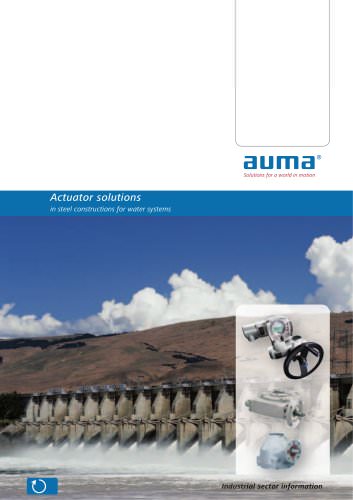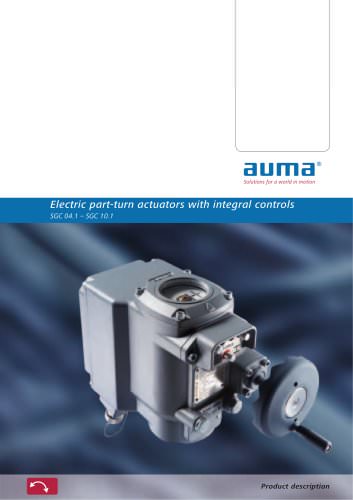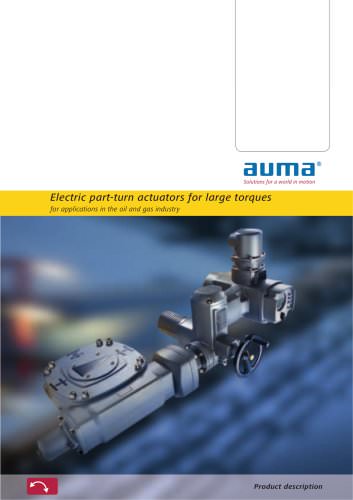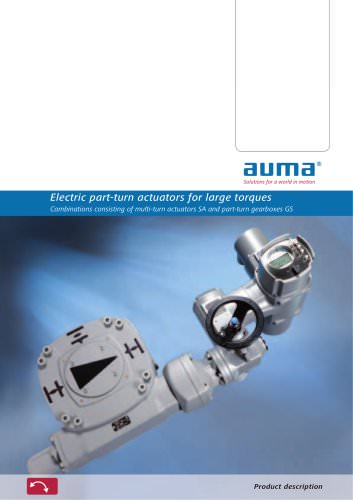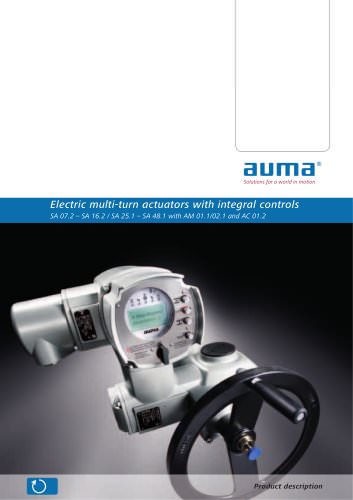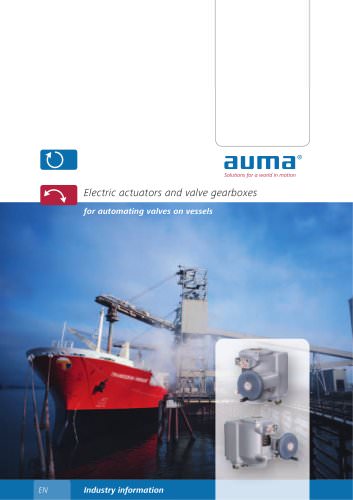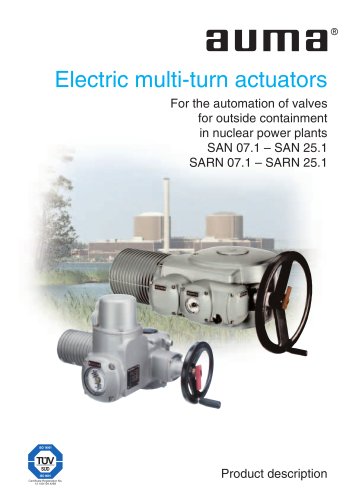
Catalog excerpts
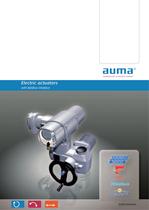
Electric actuators with fieldbus interface Solutions for a world in motion
Open the catalog to page 1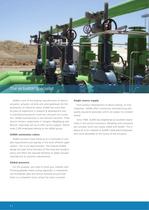
The actuator specialist AUMA is one of the leading manufacturers of electric actuators, actuator controls and valve gearboxes for the automation of industrial valves. AUMA has more than 45 years of experience in research & development and in manufacturing electric multi-turn and part-turn actuators. AUMA manufactures in two German factories. Three Service Centers, respectively in Cologne, Magdeburg and Munich, have been set up to offer service support. Worldwide 2,200 employees belong to the AUMA group. AUMA automates valves AUMA actuators have stand up to a multitude of complex...
Open the catalog to page 2
Modular design - flexible applications 5 General fieldbus information 6 General fieldbus information - device integration 10 AUMA actuators with fieldbus interfaces 20 ieldbus master and actuators from a single source 24 AUMA presales & after-sales 26 Quality is not just a matter of trust 29 Solutions for a world in motion This brochure is intended for project engineers and purchasing managers who would like to use AUMA actua- tors with fieldbus interfaces. It offers an introduction to fieldbus technology, an overview of the fieldbus systems supported by AUMA and in particular the...
Open the catalog to page 3
Applications Power : Conventional power plants (coal, gas, oil) : Hydroelectric power plants : Geothermal power plants : Solar thermal power plants : Biogas power plants Water sector Industrial and special solutions: Sewage treatment plants Water treatment plants Drinking water distribution Seawater desalination Steel construction for water resources Exploration, offshore plants Refineries Distribution Gas tanks Tank farms Air conditioning Food industry Chemical/pharmaceutical industry Vessel and submarine shipbuilding Steel mills Paper industry Cement works Mining
Open the catalog to page 4
Individual solutions for individual challenges There is no such thing as a standard actuator, even if most processes appear to be standardised. Because all industrial processes have their own specific particularities. Therefore, AUMA always produces individually customised solutions and only manufactures upon receipt of order. The multitude of existing valve types, Distributed Control Systems, application conditions and standards call for flexible actuator and controls solutions. Always tailormade to suit the appropriate application whilst respecting customer demands. Modular design...
Open the catalog to page 5
A fieldbus is an industrial communication system, connecting a variety of field devices such as transducers (sensors), MOVs and actuators (drives) with a control system. Fieldbus technology was developed in the 1980s to replace the parallel wiring of binary signals, which was common at that time, as well as analogue signal transmission by digital transmission technology. Today, many different fieldbus systems with different characteristics have become established on the market, e.g. Profibus, Interbus, ControlNet, or CAN. Since 1999, fieldbus systems worldwide have been standardised...
Open the catalog to page 6
The fieldbus replaces the parallel trunk groups by a single bus cable and connects all levels, from the field to the process control level. Whatever the automation device, e.g. programmable logic controls (PLC) from different manufacturers or computer-based controls, the fieldbus transmission medium links all components. The devices can be located anywhere in the field. Fieldbus therefore provides a powerful communication network for state-ofthe-art modernisation concepts. Digital transmission Only digital information is transmitted in fieldbus systems. Analogue setpoints or measured values...
Open the catalog to page 7
Fieldbus systems have many advantages compared to parallel wiring Reduced wiring saves time during planning and installation. The following aspects have to be considered when implementing a fieldbus system. Cables, marshalling rack and dimensions of the control cabinet will be reduced. Reducing the components reduces the documentation at the same time. More information can be transferred using fewer wires. Self-diagnosis of the devices via fieldbus reduces downtimes and maintenance times (asset management). Digitalisation of analogue values improves the protection against disturbance of...
Open the catalog to page 8
Fieldbus cables/installation Cable types Data transmission via fieldbus cannot be implemented on any cable. Cable types are specified for each fieldbus system. Due to the low data transmission rate, the requirements for Foundation Fieldbus are comparatively low; DeviceNet requires more complex cables as the bus specification requires a separate supply voltage within the same cable. Data transmission on fieldbus systems are performed with low signal levels, e.g. +/– 5 V. The installation has to be performed thoroughly to ensure fault-free data transmission. This applies to screening,...
Open the catalog to page 9
The further development of fieldbus protocols and the increasingly intelligent field devices provide the framework for a variety of additional bus-supported functionalities. This includes simplified device integration, remote programming and diagnosis of all connected devices by the bus itself via a central computer. Commissioning Contrary to conventional wiring where different signals do not interfere with each other and do not require a chronological order, fieldbus devices have to adhere to strict organisation principles to ensure fault-free communication via the common data transmission...
Open the catalog to page 10
During operation In addition to the central delimitation of communication parameters, field device configuration can be influenced online: the process behaviour, e.g. of an actuator, can be changed from the control room. The operating behaviour of the field devices can be optimised during operation without gaining access to the device. At the same time, diagnostic information is available, helping to optimise the device parameters with regards to an extended lifetime or enabling more efficient maintenance. The remote parameter setting is only possible if the fieldbus supports the...
Open the catalog to page 11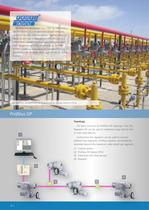
Profibus was developed from 1987 to 1989 within the framework of a co-operation project (industry, research institutes and the German federal office for research) and was translated into the DIN standard 19245 (the standardisation process was continued with the provisions of EN 50170 and IEC 61158). Further successive developments included Profibus DP, Profibus PA, Profibus DP-V1 and DP-V2, as well as ProfiNet. SA multi-turn actuators with AC integral controls in a gas station in China Probus DP Topology The basic structure for Profibus DP topology is the line. Repeaters (R) can be used to...
Open the catalog to page 12All AUMA catalogs and technical brochures
-
ELECTRIC ACTUATORS
6 Pages
-
Multi-turn actuators
92 Pages
-
Electric multi-turn actuators
40 Pages
-
SAEx 07.2
1 Pages
-
FUNCTIONAL SAFETY – SIL
28 Pages
-
Service Worldwide
8 Pages
-
SIMA² Master Station
6 Pages
-
AUMA Cloud + AUMA Assistant App
14 Pages
-
AUMA Support App
4 Pages
-
electric actuators
56 Pages
-
FUNCTIONAL SAFETY SIL
28 Pages
-
Service world wide
12 Pages
-
Explosions proof actuators
24 Pages
-
The Actuator Specialist
32 Pages
Archived catalogs
-
Test bench PV 1405
24 Pages
-
Service device PV 788 B
4 Pages
-
Electric part-turn actuators
4 Pages
-
Electric multi-turn actuators
28 Pages
-
Electric multi-turn actuators
24 Pages
-
Multi-turn gearbox GHT 360.1
4 Pages
-
Master station SIMA
4 Pages











